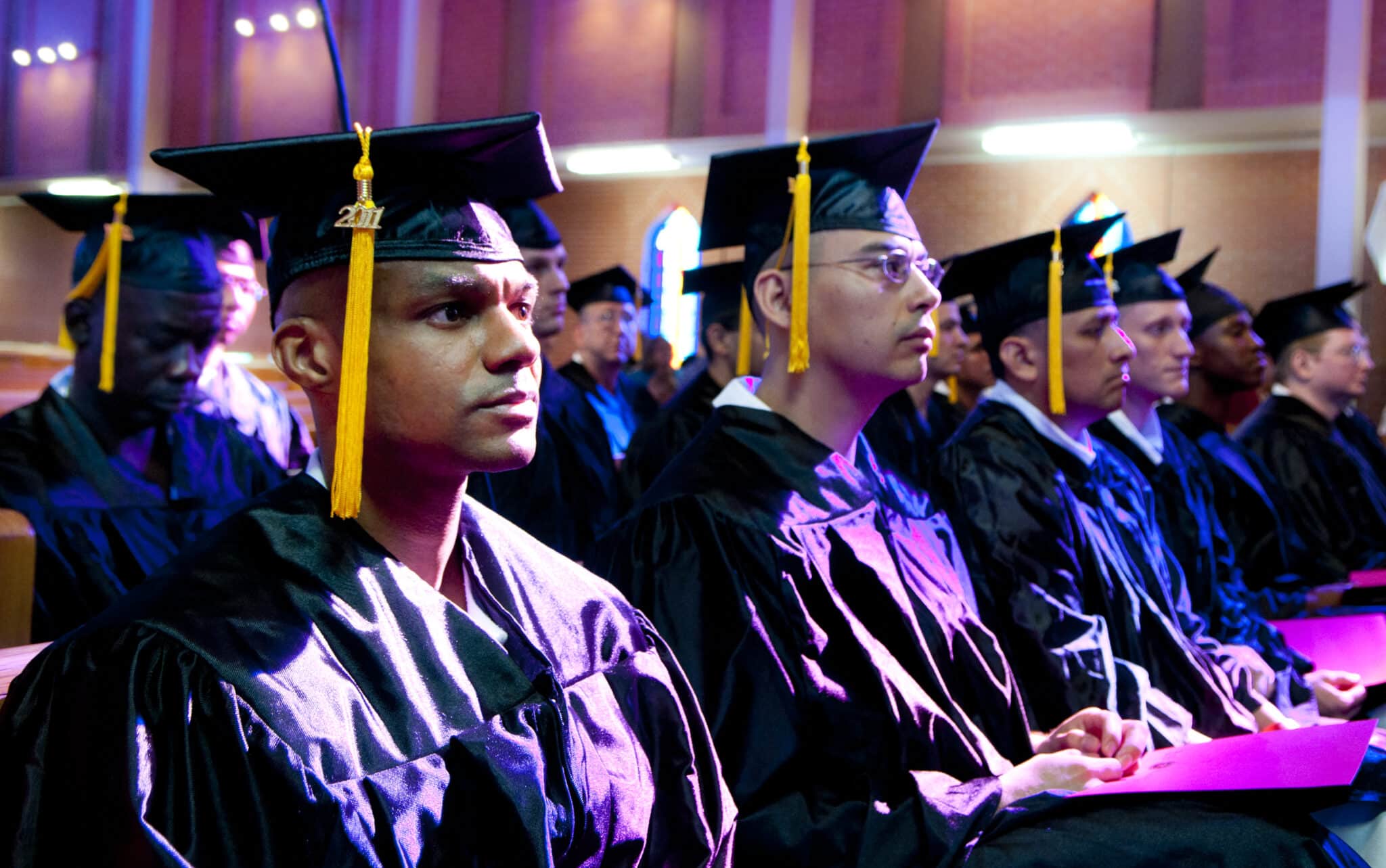Every year, hundreds of thousands of people return to the “outside” after being incarcerated, hoping for a fresh start. Yet for too many, the odds are stacked against them. Nationally, 95% of incarcerated individuals will eventually be released — but within four years, only one-third will find a job. Without education, support, and opportunities, the cycle of incarceration too often repeats itself.
Lee College in Texas is changing that. Through powerful integrated prison education and reentry programs, it is equipping justice-impacted individuals with the skills, knowledge, and confidence to build new lives. The impact reaches far beyond the individual: families are reunited, communities grow stronger, and local economies benefit.

Lee students in the truck driving certificate program at the Huntsville (“Walls”) Unit.
Lee College is not a newcomer when it comes to prison education. One of the oldest (and largest) programs of its kind in Texas, the college’s Huntsville Center, which currently enrolls more than 1,200 incarcerated individuals, began in 1965.
Today, it brings educational programming to nine of the 100 prisons throughout the state of Texas, offering an Associate of Applied Science (AAS) degree in business management; certificates and degrees in technical programs; and a six-week reentry program, founded in 2017 with Title V funds, that supports students in learning essential life skills to facilitate their successful transition to existence outside of prison walls.
For-Credit Programming
Paul Allen, academic division chair of the Lee College Huntsville Center, has been teaching incarcerated individuals full-time for the past 41 years. One would be hard pressed to find a person more dedicated to the mission of prison education than he. “Education knows no barriers,” he says. “Because you’re incarcerated doesn’t mean you’re a failure for life.”
He says a fervent belief that life can be better post-incarceration than pre-incarceration is the spirit of the Huntsville Center program. “It’s just very heartfelt to know that you’ve helped somebody do something that they never thought they would ever be able to do,” he shares. “They’re the first graduate in their family; they’ve been able to rekindle some those [family] relationships; they’ve been able to restore some lost trust. That’s the human side that really, really motivates us to do even more.”
According to Allen, 60% of the students enrolled in Huntsville Center programming never completed high school, but, through a system of supports, the center makes postsecondary credentials attainable. In addition to placing students who have successfully completed their program as embedded tutors in classes, all of the nine prison units where Huntsville Center has a presence boast student success centers, instructional labs, and are equipped for research.
As for recruitment, Allen says the benefits of educational programming are contagious in the units. “Our current students and graduates are our best recruiters down in the cell blocks because inmates see people going home. They see people getting paroled. They see people having something special in their life, and they want to know what that is. They want to be part of that.”
In addition to the AAS degree program in business management (which, thanks to a blossoming partnership with Sam Houston State University, is on track to soon offer a transfer pathway to a four-year degree in business), Lee College Huntsville Center offers a truck driving certification as well as both certifications and degrees in fields ranging from welding, cabinet making, HVAC, and auto mechanics to logistics, culinary arts, horticulture, and microcomputer applications.
The college ensures that certificate programs result not just in a college certificate but an industry-credential that will assist graduates in getting jobs after release. While the availability of the technical programming to students is dependent upon which unit a student resides, it is entirely possible for a student to acquire both the AAS degree (offered on all nine units) as well as one or two technical credentials.
The business management degree is often a perfect complement to a technical degree, explains Donna Zuniga, associate vice president of the Huntsville Center, as many students hope to own their own business one day. She points to the incredible success of one graduate of the HVAC program who established his own HVAC company, employed other graduates of Huntsville Center’s HVAC program, and eventually sold the business for several millions of dollars.
As for the success of for-credit programs at Lee College Hunstville Center, the metrics speak for themselves. Among full-time students, three-year completion rates for the associate degree and 18-month completion rates for the certificate programs average roughly 85%.
The rate is so high, says Allen, that people hearing it are often incredulous. “People say, ‘Well, how do y’all do it? That success rate is unheard of. Your quality must not be the same as [on the main] campus.” But Allen says they have the data to prove otherwise. A big part of his job, he says, is ensuring that the same standards for instruction and accreditation that are used for their standard programs are duplicated for the Huntsville center programs.
In addition to looking forward to the establishment of the four-year transfer pathway, administrators, faculty, and staff at Lee College are hopeful about other forms of expansion.
The recent reinstatement of Pell Grants for incarcerated individuals wishing to participate in postsecondary education — a source of need-based support that was cut off with the passing of the 1994 crime bill — has been a “game changer,” according to Zuniga.
Lee was fortunate enough to be accepted into the Second Chance Pell pilot program in 2016, and last month, after multiple approval processes, received notification from the Department of Education that the college now has permanent status as a recognized prison education program for the Second Chance Pell. “We’re very proud of that. So, of course, now we’re looking to possibly add some programs,” Zuniga says.
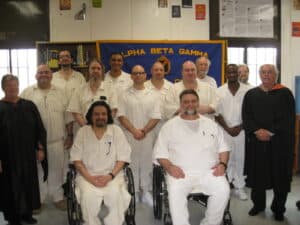
Lee College Huntsville Center faculty members and students from the Wallace Park Unit at the students’ induction into the Alpha Beta Gamma National Honor Society.
Reentry Program
Though much newer than the 60-year-old prison education program, Lee College’s reentry program — the only community college-based reentry program in the state — is having a substantial impact. Open to any student who has taken classes through the Huntsville Center, the reentry program supports students (on the same nine prison units served by the center) with preparations for reintegrating back into society.
According to Director of Reentry Services Tracy Williams, the student services side of the program focuses on teaching students the skills they will need to thrive on the outside, covering topics such as resume writing, critical thinking, and soft skills, including behaviors expected by employers, how to develop credit and track personal finances — even the basics on finding health insurance.
A large component of the services focuses on developing digital skills, which are critically important, particularly for those students who have been incarcerated for extended periods of time and will face a largely unknown digital world upon release.

Students in the horticulture program at the Lucile Plane State Jail for women.
“If you are someone in this world and you don’t know anything about computers or the basics about a phone or email, you’re going to be lost,” explains Williams. “And for a person that has a skill or education, that can really hamper that person’s adjustment back into society. So, that’s what we want to be able to do — make our students be the most successful they can be.”
Digital literacy is such an essential part of successful reintegration that Williams says they are considering extending the six-week program by two additional weeks in order to provide an even greater digital focus.
In addition to student services, the reentry program also offers a vast array of benefits from its extensive alumni network. Composed of 780 former Lee College students who were formerly incarcerated and over 200 other previously incarcerated people across Texas, members of the alumni network connect with Lee students who have recently been released to provide mentorship — whether that be in the form of virtual support groups that offer help with cell phone use or setting up an email account or assistance with finding employment.
Having grown in popularity, Lee’s reentry program runs two to three times per year on each of the nine prison units and annually graduates approximately 300 students. For those who are unable to participate in the class due to scheduling conflicts with their for-credit classes, Williams and his colleagues give special presentations at various times during the year at the units to ensure the information is widely available.
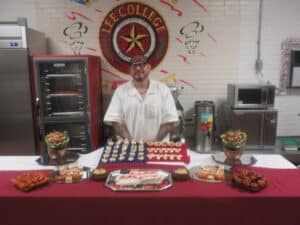
A culinary student from the J. Dale Wainwright Unit shows off his creations.
They also publish booklets and other resources as handouts. As these printed resources travel with individuals through prison transfers, incarcerated individuals residing in facilities without a reentry program often write to Lee’s program to request more information. “We’ve gotten a lot of requests from all over the state,” says Williams.
This clamoring for reentry assistance has inspired the idea of creating a reentry podcast. While the 130,000 incarcerated people across Texas have state-issued tablets, they do not currently have internet connectivity. Williams hopes there is a way to make a podcast accessible via the tablets in order to further spread helpful information.
Measures of Positive Impact
In determining the impact of prison education programming, people often look to the programming’s effect on recidivism rates. Among Lee college students who have completed a degree or certificate through the Huntsville Center, recidivism currently stands at 11.1% — a rate that confirms the positive influence of prison education when compared to Texas’ recidivism rate of 16.7 among those who do not participate in prison education.
Dr. Douglas Walcerz, provost and vice president of academic and student affairs at Lee College, is quick to point out the difference between recidivism and desistance. He compares a student who is released, gets a job and housing, reintegrates with family, and supports their children with a student who gets released, commits crimes, uses drugs, overdoses, and dies.
“Both of those are success stories from a recidivism standpoint because neither one went back to prison [with]in three years,” he explains. “But desistance is about measuring the behaviors that lead to pro-social interaction, and [so] measuring desistance is more meaningful for us than recidivism. That’s part of what our reentry class is focused on: not just recidivism but desistance. Harder to measure, but more meaningful.”
Williams says Lee’s reentry program takes steps to measure desistance. Through surveys, they attempt to capture how formerly incarcerated students are faring by asking about their financial situation, their quality of life, if they are engaging in civic events, and other markers of pro-social behavior. “We ask, ‘Does a person feel more hopeful?’ In the class, we try to give individuals hope, knowing that they can go out there and live their best life, and not go back to crime,” he states.
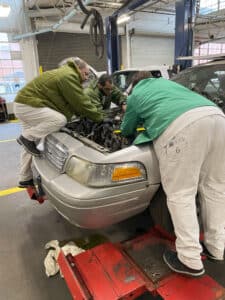
Lee students in the Texas State Penitentiary at Huntsville work to repair a car as part of their training in the auto mechanics program.
The Case for Second Chances
Prison education programs are often met with skepticism, but the question shouldn’t be “Why invest in them?”— according to Dr. Walcerz, it should be “Why not?” He argues that there are significant benefits for all stakeholders. “Over 95% of people who are incarcerated are going to return [to society], and they’re going to return all over the United States,” he says. “What kind of person do you want returning to your neighborhood? I want a college-educated person.”
From a purely practical standpoint, Zuniga underscores the positive return on investment in prison education. It gives [incarcerated individuals] the opportunity to go back and to be a good citizen, to pay taxes rather than being supported on our taxes,” she points out.
Zuniga also mentions the less tangible — but no less impactful — effect on families. “To be able to reunite with families and be successful … the impact [that has] on children that have incarcerated parents is huge and is not really addressed as it should be,” she adds.
There is another community that feels the positive effects of prison education, Zuniga says, and it is one that is often overlooked. In addition to better equipping the individual students who reenter society, stabilizing their family units, and uplifting neighborhoods, prison education has positive outcomes for the prison communities themselves.
“Many wardens tell us … it reduces the amount of problems they have inside the prison,” she reports. “The Department of Corrections gets a lot of value from having college education training on their units. It changes the culture of a unit … There’s less violence, fewer issues,” she notes. “If there’s an individual serving a life sentence, people would say, “Why would you educate somebody that’s never going to get out?’ [It’s because] that individual can impact many, many other individuals in there and guide them.”
For Williams, who served over 25 years in prison, a great deal of the value in a prison education program is in the optimism it brings to its students. “Education is so transformative,” he says. “It changes your mindset. It changed my mindset, my thinking. And so that is ‘the why,’ you know? To give individuals hope.”
When it comes to prison education, Lee College’s story is one of resilience, redemption, and the transformative power of second chances. It stands as compelling evidence that education can disrupt cycles of incarceration and open the door to brighter futures — not just for individual students, but for families, communities, and society as a whole. More profoundly, it affirms a simple but powerful truth: people are not defined by their worst mistakes. With access to education and a network of support, meaningful change is not only possible — it is happening every day. As Williams reflects from personal experience, “People do change. Despite mistakes or past bad decisions. People do change.”

Graduating students at Lee College Huntsville Center’s Commencement ceremonies.
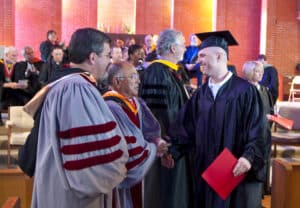
A student receives his diploma.
